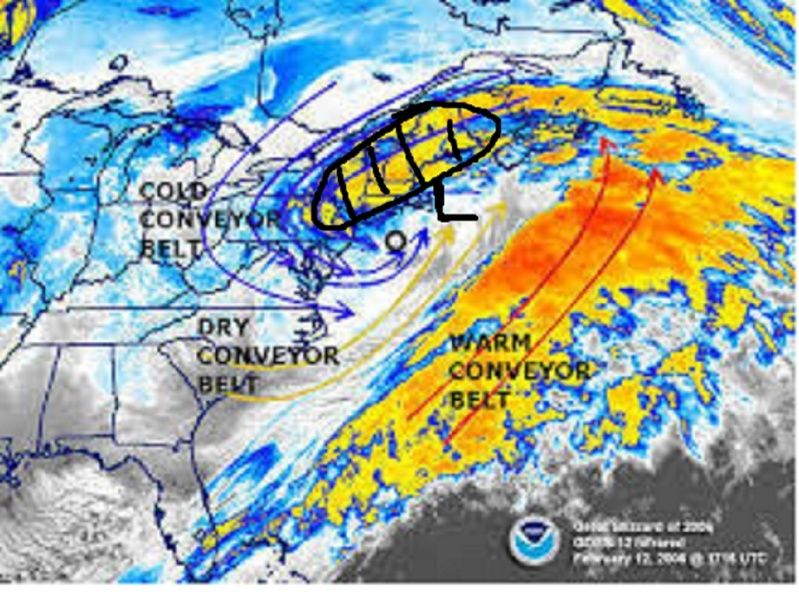CCB Banding (Cold Air Conveyor Belt)
2 posters
Page 1 of 1
 CCB Banding (Cold Air Conveyor Belt)
CCB Banding (Cold Air Conveyor Belt)
For those who want to know a bit more about what a CCB is as well as the CCB bands that develop. Here is the visual. Obviously these are not all the same storm. But you get the picture.
The air in the cold air conveyor belt (CCB) travels underneath the air associated with the warm conveyor belt. This is the basics of a warm frontal boundary. With a strong intense LP to the NW of the LP the CCB banding sets up. This is because there is enhanced lifting mechanisms in this zone. The enhanced lift in these zones can lead to very heavy banding of precip. That's the simple version. I provided a little more technical version below the images:

 " />
" />

 " />
" />

 " />
" />
"Air in the cold conveyor belt originates in the lower troposphere of the downstream anticyclone(low pressure) and passes underneath the warm-frontal zone . Thus, the warm front separates the warm and cold conveyor belts. Potential vorticity(spin) is created in the cold conveyor belt beneath the area of latent heat release in the ascending warm conveyor belt. The increasing potential vorticity(spin) within the cold conveyor belt is transported westward toward the lower-tropospheric cyclone center. As demonstrated by Stoelinga (1996) and Rossa et al. (2000), the diabatically( latent heat released)-generated potential vorticity can enhance the cyclonic circulation about the surface cyclone without appreciably affecting the location and overall structure of the cyclone.
Since any precipitation generated within the warm conveyor belt must fall through the cold conveyor belt, the temperature and humidity of the cold conveyor belt can play an important role in controlling the type and amount of precipitation reaching the surface."
The air in the cold air conveyor belt (CCB) travels underneath the air associated with the warm conveyor belt. This is the basics of a warm frontal boundary. With a strong intense LP to the NW of the LP the CCB banding sets up. This is because there is enhanced lifting mechanisms in this zone. The enhanced lift in these zones can lead to very heavy banding of precip. That's the simple version. I provided a little more technical version below the images:
 " />
" /> " />
" /> " />
" />"Air in the cold conveyor belt originates in the lower troposphere of the downstream anticyclone(low pressure) and passes underneath the warm-frontal zone . Thus, the warm front separates the warm and cold conveyor belts. Potential vorticity(spin) is created in the cold conveyor belt beneath the area of latent heat release in the ascending warm conveyor belt. The increasing potential vorticity(spin) within the cold conveyor belt is transported westward toward the lower-tropospheric cyclone center. As demonstrated by Stoelinga (1996) and Rossa et al. (2000), the diabatically( latent heat released)-generated potential vorticity can enhance the cyclonic circulation about the surface cyclone without appreciably affecting the location and overall structure of the cyclone.
Since any precipitation generated within the warm conveyor belt must fall through the cold conveyor belt, the temperature and humidity of the cold conveyor belt can play an important role in controlling the type and amount of precipitation reaching the surface."
_________________
"In weather and in life, there's no winning and losing; there's only winning and learning."
WINTER 2012/2013 TOTALS 43.65"WINTER 2017/2018 TOTALS 62.85" WINTER 2022/2023 TOTALS 4.9"
WINTER 2013/2014 TOTALS 64.85"WINTER 2018/2019 TOTALS 14.25" WINTER 2023/2024 TOTALS 13.1"
WINTER 2014/2015 TOTALS 71.20"WINTER 2019/2020 TOTALS 6.35" WINTER 2024/2025 TOTALS 0.00
WINTER 2015/2016 TOTALS 35.00"WINTER 2020/2021 TOTALS 37.75"
WINTER 2016/2017 TOTALS 42.25"WINTER 2021/2022 TOTALS 31.65"

sroc4- Admin

- Posts : 8458
Reputation : 302
Join date : 2013-01-07
Location : Wading River, LI
 Re: CCB Banding (Cold Air Conveyor Belt)
Re: CCB Banding (Cold Air Conveyor Belt)
With the upcoming storm POTENTIAL, there has been a lot of chatter about CCB's and deformation zones. So sroc's post here is a good read for people not familiar with that meteorological terminology. I think this link is also good:
http://www.crh.noaa.gov/Image/lmk/pdf/deformation_zones.pdf
http://www.crh.noaa.gov/Image/lmk/pdf/deformation_zones.pdf

billg315- Advanced Forecaster - Mod

- Posts : 4564
Reputation : 185
Join date : 2015-01-24
Age : 50
Location : Flemington, NJ
Page 1 of 1
Permissions in this forum:
You cannot reply to topics in this forum
 Home
Home